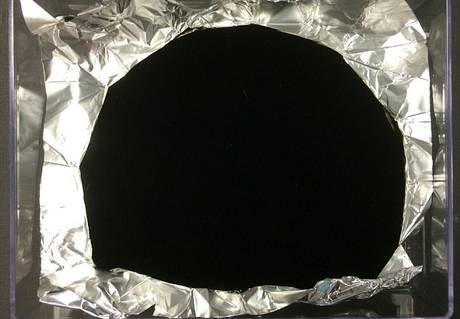Super Black: 'Strange, Alien' Darkest Material Ever Created is Incomprehensible to Human Eye

A British company has created a "strange, alien" material so dark that it absorbs the majority of visual light.
The new "super black" coating made of carbon nanotubes absorbs all but 0.035% of visual light, setting a new world record. Each nanotube is 10,000 times thinner than a human hair.
It is so dark that the human eye cannot comprehend what it is seeing, as shapes and contours are lost, leaving only a hole.
The material's maker Surrey NanoSystems, based in Newhaven, has said potential applications involve calibrating astronomical cameras and infrared scanning systems, but there are also military uses that are not allowed to be discussed.
"It reduces stray-light, improving the ability of sensitive telescopes to see the faintest stars, and allows the use of smaller, lighter sources in space-borne black body calibration systems. Its ultra-low reflectance improves the sensitivity of terrestrial, space and air-borne instrumentation," said Ben Jensen, the company's chief technical officer.
The nanotube material, called Vantablack, has been grown on sheets of aluminium foil by the company. Although the foil can be crumpled into tiny crevices, the crinkled landscape on the areas covered by the material vanish.
"You expect to see the hills and all you can see ... it's like black, like a hole, like there's nothing there. It just looks so strange," Jensen told the Independent.
If it were to be used on a dress, he added it would be "very expensive" - but was unable to reveal the actual cost of the material.
"You would lose all features of the dress. It would just be something black passing through," he said.
The material works by closely packing together nanotubes, which are so miniscule that light particles cannot enter them, although they can pass into the gaps in between. Once there, all but a tiny amount of the light bounces around until it is absorbed.
Vantablack is expected to be used in astronomical cameras, telescopes and infrared scanning systems. It can be used to take photographs of the oldest objects in the universe, which has been done by pointing the camera at something as black as possible.
Jensen added that the material has the advantage of having "virtually undetectable levels of outgassing and particle fallout", which contaminate sensitive imaging systems.
Vantoblack has ten times the tensile strength of steel and conducts heat seven and a half times more effectively than copper, the Digital Journal reported. It is said to withstand space-launch shock and vibration and exhibits excellent thermal stability.
Stephen Westland, professor of colour science and technology at Leeds University, told the Independent: "Many people think black is the absence of light. I totally disagree with that."
"Unless you are looking at a black hole, nobody has actually seen something which has no light," he said. "These new materials, they are pretty much as black as we can get, almost as close to a black hole as we could imagine."
Vantablack will be launched at the Farnborough International Airshow this week and was described in the journal Optics Express.
© Copyright IBTimes 2025. All rights reserved.






















